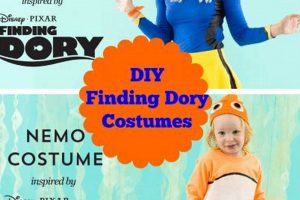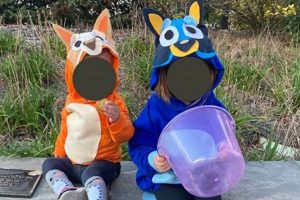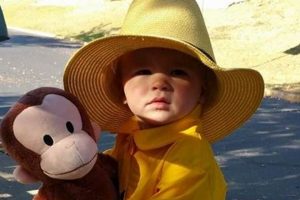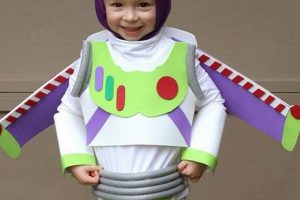The construction of a homemade burlap sack monster outfit allows individuals to creatively embody a recognizable character. This undertaking typically involves utilizing accessible materials and personal ingenuity to replicate the distinct aesthetic of a well-known fictional entity. This approach offers a budget-conscious and customizable alternative to purchasing commercially manufactured apparel.
Engaging in this type of creative project fosters resourcefulness and provides an opportunity for personal expression. The process encourages the development of practical skills in areas such as sewing, crafting, and design. Historically, such homemade attire has been a common practice, particularly for celebratory events where pre-made options were either unavailable or unaffordable, leading to unique and personalized interpretations of popular figures.
The following sections will delve into specific techniques and considerations for successfully creating this type of unique character representation. Material selection, construction methods, and finishing details will be discussed to guide the reader through the entire building process.
Construction Advice
Careful consideration of materials and construction techniques is essential for a successful outcome. Attention to detail in pattern creation and assembly significantly impacts the final product’s appearance and durability.
Tip 1: Material Selection: Burlap forms the foundation. Choose a weight appropriate for the intended use. Lighter weights are easier to sew but may require reinforcement. Muslin or canvas can line the inside for comfort and durability. Consider using different fabric types or colors for variations within the costume itself.
Tip 2: Pattern Creation: Begin with basic shapes. An oversized sack pattern can serve as the body. Individual limbs, like arms and legs, should be constructed separately and attached. Consider the need for internal volume and adjust pattern pieces accordingly.
Tip 3: Stitching Techniques: Employ durable stitching methods to ensure the costume’s longevity. A zig-zag stitch reinforces seams and prevents fraying, especially with loosely woven burlap. Reinforce high-stress areas such as arm and leg attachments.
Tip 4: Stuffing and Support: Consider the stuffing material carefully. Polyfill provides a lightweight option, while recycled materials offer an eco-friendly alternative. Internal supports, such as wire or batting, can help maintain the costume’s shape.
Tip 5: Feature Implementation: The signature stitches or seams should be carefully planned. Contrasting thread, such as black or dark brown, creates a visually striking effect. These can be hand-stitched or machine-sewn for uniformity.
Tip 6: Visibility and Mobility: Incorporate viewing ports. Mesh or sheer fabric allows the wearer to see without compromising the costume’s integrity. Ensure adequate room for movement, particularly in the arms and legs.
Successful construction hinges on precise execution and careful attention to detail. Following these guidelines will significantly enhance the costume’s overall aesthetic and durability.
The following sections will address specific stylistic choices and finishing touches that elevate the overall quality and authenticity of this creative endeavor.
1. Burlap Texture Variation
Burlap texture variation exerts a direct influence on the overall visual fidelity of the homemade burlap sack monster attire. The selection of a specific burlap weave affects the costume’s perceived authenticity and aesthetic appeal. Coarser weaves offer a more rugged, timeworn appearance, aligning with the character’s dilapidated aesthetic. Conversely, finer weaves may project a more refined, albeit potentially less accurate, interpretation. For instance, using a loosely woven burlap with visible gaps enhances the sense of decay, whereas a tightly woven burlap, while more durable, diminishes this effect. Consequently, the choice of burlap texture constitutes a critical decision in the construction process, impacting the final representation’s verisimilitude.
Considering practical application, the selected burlap texture also influences the costume’s structural integrity and ease of manipulation. A thicker, coarser burlap, while visually appealing, may prove challenging to sew and manipulate into complex shapes, potentially requiring specialized tools and techniques. Conversely, a thinner, finer burlap facilitates easier sewing and shaping but might necessitate additional reinforcement to maintain the costume’s structural form. In cases where a lighter fabric is desired, multiple layers can be used to mimic the appearance of a heavier burlap, offering a compromise between visual accuracy and ease of construction. The character’s inherent texture plays a vital role in the finished costume effect.
In conclusion, understanding the impact of burlap texture variation is paramount when crafting a homemade burlap sack monster outfit. The selection influences not only the costume’s visual accuracy but also its structural properties and ease of construction. A deliberate choice, balancing aesthetic goals with practical considerations, ultimately contributes to a more successful and visually compelling outcome. The inherent texture adds significantly to the costume’s overall impact.
2. Stitch Detailing Accentuation
Stitch detailing accentuation plays a pivotal role in the successful execution of a homemade burlap sack monster outfit. The character’s visual identity is inextricably linked to the prominent, often contrasting, stitches that define its form and texture. Therefore, the degree to which these stitches are emphasized directly impacts the costume’s recognizability and aesthetic appeal. A poorly executed stitching detail can detract from the overall effect, diminishing the costume’s resemblance to the intended subject. Conversely, carefully accentuated stitches enhance the burlap texture, reinforcing the character’s unique appearance.
Real-world examples demonstrate the practical significance of this element. Costumes lacking sufficient stitch detailing often appear generic or incomplete, failing to capture the nuances of the source material. In contrast, costumes with exaggerated, deliberately contrasting stitches immediately establish a strong visual connection. For example, utilizing a thick, dark brown thread against a light-colored burlap creates a striking visual contrast, effectively replicating the character’s signature aesthetic. Furthermore, varying stitch patterns and densities can add depth and dimension to the costume, further enhancing its realism. The spacing and size of stitches contribute to the visual representation of the character.
In summary, stitch detailing accentuation is not merely a cosmetic addition but a fundamental aspect of creating a c
onvincing burlap sack monster costume. The strategic use of contrasting thread, varied stitch patterns, and deliberate emphasis on these details significantly elevates the costume’s visual impact, increasing its recognizability and overall aesthetic appeal. Failing to prioritize this element can result in a less effective and visually uninspired creation. Proper accentuation creates a more visually stunning final product.
3. Internal Support Framework
An internal support framework is a critical, yet often unseen, component in constructing a successful self-made burlap sack monster costume. This framework provides structural integrity, dictating the costume’s shape and preventing it from collapsing under its own weight or the wearer’s movements. Without adequate internal support, the costume risks appearing misshapen or deflated, diminishing the intended visual impact. The absence of a framework compromises the overall aesthetic and may also restrict the wearer’s mobility and comfort. For instance, a wire armature can provide rigidity to limbs, allowing them to maintain their intended pose, while strategically placed padding can add volume and prevent the burlap from clinging to the wearer’s body. The framework directly affects how the costume appears and functions.
Practical applications of internal support frameworks vary depending on the desired outcome and materials used. Simple frameworks can consist of strategically placed batting or foam to provide basic volume and shape. More complex frameworks might employ wire, PVC piping, or even lightweight wooden structures to achieve more elaborate designs and greater stability. In scenarios where mobility is paramount, flexible materials are preferred. Conversely, for static display or when a specific, unchanging shape is required, more rigid materials offer superior support. Costumes intended for prolonged wear benefit from breathable and lightweight framework materials to minimize discomfort. Examples include using hula hoops to maintain a rounded body shape or employing foam tubing to create defined limb structures.
In conclusion, the internal support framework is an indispensable element in the creation of a durable and visually compelling burlap sack monster costume. Its design and implementation directly influence the costume’s shape, stability, and wearer comfort. By carefully considering the materials and construction techniques used to create this framework, the costume’s overall quality and impact can be significantly enhanced. The framework serves as the invisible backbone, allowing the burlap exterior to achieve its intended aesthetic and functional goals.
4. Filler Material Selection
Filler material selection is a critical determinant in the final form and wearability of a homemade burlap sack monster costume. The choice impacts not only the costume’s volume and shape but also its weight, comfort, and overall aesthetic. Different materials provide distinct characteristics that must be considered in relation to the desired appearance and functionality.
- Weight and Density
The weight and density of the filler material directly influence the costume’s overall mass and perceived bulk. Lightweight options such as polyfill or foam batting reduce strain on the wearer, facilitating prolonged use and increased mobility. Conversely, denser materials like fabric scraps or sand provide a more substantial feel and can enhance the costume’s shape, particularly in areas requiring defined contours. However, excessive weight can lead to discomfort and limit maneuverability. For instance, a costume filled entirely with sand, while achieving a realistic drape, would be impractical for active wear.
- Shape Retention
The capacity of the filler material to maintain its form over time dictates the costume’s long-term visual integrity. Materials with high shape retention, such as sculpted foam or strategically placed wire armatures, prevent sagging and distortion, preserving the intended silhouette. Conversely, less rigid options, like loose fabric scraps, may require frequent adjustments to maintain their shape. An example includes using expanding foam to create rounded features that retain their form, compared to using loosely packed batting that may flatten over time.
- Texture and Visual Impact
The inherent texture of the filler material, although often concealed, can indirectly influence the costume’s final appearance. Lumpy or uneven fillers can create surface irregularities visible through the burlap, adding to the character’s grotesque aesthetic. Uniform fillers produce a smoother, more consistent surface. For example, using crumpled newspaper as filler can generate a more uneven and textured look compared to using smooth polyfill. The selected material impacts the look and visual effect of the finished costume.
- Cost and Availability
Economic considerations play a significant role in filler material selection. Readily available and inexpensive options, such as recycled materials or salvaged fabrics, offer a cost-effective alternative to commercially produced fillers. However, these materials may compromise on desired properties like weight, shape retention, or uniformity. Polyfill and sculpted foam, while offering superior performance, come at a higher price point. The choice often involves a trade-off between budget constraints and desired quality. Free or recycled materials affect cost and often impact appearance.
Ultimately, the optimal filler material selection for a homemade burlap sack monster costume depends on a complex interplay of factors, including desired aesthetic, wearability, budget, and the wearer’s physical capabilities. A well-considered choice maximizes the costume’s visual impact and ensures a comfortable and enjoyable experience.
5. Visibility Implementation Strategy
A carefully considered visibility implementation strategy is paramount in the construction of a self-made burlap sack monster costume. Adequate visibility ensures the wearer’s safety and comfort, directly impacting their ability to navigate and interact with their surroundings. The absence of a well-defined visibility plan compromises the wearer’s experience and potentially poses safety hazards. Therefore, integrating effective viewing mechanisms is a critical design consideration.
- Mesh Integration Techniques
The integration of mesh materials offers a discreet method for enhancing visibility without significantly detracting from the costume’s aesthetic. Mesh, strategically placed within shadowed areas or disguised as part of the costume’s texture, allows the wearer to see outwards while maintaining the illusion of a solid form. For example, fine black mesh positioned within the “mouth” or “stitches” of the costume provides an unobstructed view while remaining visually consistent with the character’s design. The effectiveness of mesh integration depends on selecting a mesh density that balances visibility with concealment and minimizes distortion of the wearer’s field of view. Light affects how the mesh material performs
: darker mesh, positioned correctly, is harder to spot. - Periscope Systems
Periscope systems, while more complex to implement, provide an alternative approach to achieving visibility without direct openings in the costume’s surface. This method involves utilizing a series of mirrors or prisms to redirect the wearer’s line of sight to a viewing point concealed within the costume’s interior. Periscope systems offer greater flexibility in placement and can be adapted to accommodate diverse costume designs. Real-world applications might include a miniature periscope embedded within the costume’s “head,” allowing the wearer to see forward while maintaining the character’s distinct silhouette. Precision and careful alignment are essential to ensure a clear and undistorted field of vision. This also introduces a separate construction requirement.
- Camera and Screen Integration
The integration of miniature cameras and screens represents a technologically advanced visibility solution. A small camera mounted on the costume’s exterior transmits a live video feed to a screen positioned within the wearer’s field of view. This approach offers unparalleled flexibility in viewing angles and can even incorporate features like night vision or zoom capabilities. Practical examples include a camera discreetly integrated into the costume’s “eye,” providing the wearer with a wide-angle view of their surroundings displayed on a small LCD screen attached to the inside of the mask. However, this method requires a power source and adds complexity to the costume’s construction. Power requirements are an addition that may introduce a new challenge for the maker.
- Strategic Slit Placement
Strategic slit placement involves incorporating narrow openings into the costume’s design to provide viewing access without compromising the overall aesthetic. These slits, often disguised as seams or textural elements, allow the wearer to see outwards while minimizing their visibility to observers. For instance, vertical slits concealed within the folds of the burlap fabric, strategically positioned at eye level, offer a subtle yet effective viewing solution. The effectiveness of this method relies on carefully calibrating the slit width and placement to maximize visibility while minimizing visual disruption. The placement of slits must be done with care and attention, so that the wearer of the costume can see.
Each visibility implementation strategy presents unique advantages and disadvantages. The optimal choice depends on factors such as the costume’s design, the wearer’s comfort requirements, and the desired level of visual fidelity. Regardless of the chosen method, prioritizing safety and ensuring a clear and unobstructed field of view is paramount to a successful and enjoyable experience. Effective viewing mechanisms enable the costume to be both aesthetically pleasing and practically functional.
Frequently Asked Questions
This section addresses common inquiries and concerns regarding the creation of a homemade burlap sack monster costume. The information provided aims to clarify key aspects of the construction process and offer guidance on achieving a successful outcome.
Question 1: What is the recommended type of burlap for optimal results?
A medium-weight burlap is generally advisable. Lighter burlap may lack durability, while heavier burlap can be difficult to manipulate. A balance between these properties facilitates both ease of construction and structural integrity. The texture of the burlap is a key factor in this decision.
Question 2: How can the costume’s shape be maintained without an internal framework?
Strategic use of stuffing and quilting techniques can provide structural support. Dense packing of filling materials in key areas, combined with quilting to secure the burlap layers, can help maintain the desired shape. Note that this provides less structure than an internal frame and shape might shift with movement.
Question 3: What are the safest methods for ensuring adequate visibility while wearing the costume?
Mesh inserts, carefully concealed within the design, offer a viable solution. The mesh should be dark in color to minimize visibility from the outside while allowing the wearer a reasonable field of vision. Slits are a secondary option, but may compromise visual appearance.
Question 4: How can the costume be made more comfortable for extended wear?
A lining of soft, breathable fabric, such as muslin, can significantly improve comfort. This lining reduces friction between the burlap and the wearer’s skin, minimizing irritation. Proper ventilation is also helpful, by allowing the costume to breathe.
Question 5: What type of stitching is recommended to prevent seams from unraveling?
A reinforced stitch, such as a zig-zag stitch or a double stitch, is advisable for securing seams. These stitches provide added strength and prevent the loosely woven burlap from fraying. Backstitching each seam may be needed for longevity.
Question 6: How can the costume be adapted for different weather conditions?
In warm weather, a lightweight burlap and breathable lining are essential. In colder conditions, additional layers of insulating fabric can be added beneath the burlap. Consider the wearers climate when making material decisions.
These FAQs provide a foundation for addressing common challenges encountered during burlap sack monster costume construction. By considering these factors and implementing appropriate solutions, a more successful and enjoyable outcome can be achieved.
The subsequent section will explore advanced techniques and customization options for further enhancing the costume’s aesthetic and functionality.
diy oogie boogie costume
This exploration has detailed the multifaceted considerations involved in fabricating a homemade burlap sack monster outfit. From the selection of appropriate burlap weaves to the strategic implementation of visibility solutions and internal support structures, each element contributes significantly to the final product’s aesthetic quality and functional efficacy. The accentuation of stitch details and the judicious choice of filler materials further refine the costume’s overall verisimilitude. Careful attention to these factors separates a rudimentary attempt from a compelling representation.
Mastering these techniques empowers individuals to create unique and memorable character portrayals. The principles outlined herein extend beyond this specific application, offering valuable insights applicable to a range of costume design and fabrication projects. Continued refinement and innovative adaptation of these methods will undoubtedly foster increasingly sophisticated and visually impactful creations. The pursuit of excellence in costume craftsmanship demands diligent practice and a commitment to continuous learning.


![Groovy, Baby! Austin Powers Costume DIY Guide [Easy] The DIY Hub: Creative Crafts, Repairs & Life Hacks Groovy, Baby! Austin Powers Costume DIY Guide [Easy] | The DIY Hub: Creative Crafts, Repairs & Life Hacks](https://craftingdiycenter.com/wp-content/uploads/2025/07/th-7257-300x200.jpg)




